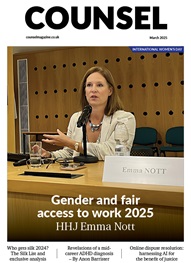*/
Almost two-thirds of the lawyers recruited to become judges last year went to state schools, according to the latest figures from the Judicial Appointments Commission (JAC).
The data was based on 28 selection exercises conducted in the year ending March 2018, for which 5,125 lawyers applied and 729 were recommended for appointment.
In the legal competitions, 63% of those recommended for immediate appointment were educated at a state school, compared to 35% who went to fee-paying schools, with 2% educated abroad. In addition, 59% were the first in their family to have attended university.
Overall, 40% of those recommended for immediate appointment were women, only 9% came from a black or ethnic minority background and 7% said that they had a disability.
Barristers still accounted for most applications and appointments – solicitors made up 36% of applicants and 21% of those recommended, while barristers represented 50% of applicants and 59% of those recommended.
When it came to appointments to the High Court, 52% had attended a state school and 47% had been educated privately, 27% were female and 5% were from an ethic minority background.
The JAC statistics suggest that the judiciary, which has traditionally been dominated by white men who attended private schools, may slowly be becoming more diverse, although more than 70% of senior judges are from private schools.
Almost two-thirds of the lawyers recruited to become judges last year went to state schools, according to the latest figures from the Judicial Appointments Commission (JAC).
The data was based on 28 selection exercises conducted in the year ending March 2018, for which 5,125 lawyers applied and 729 were recommended for appointment.
In the legal competitions, 63% of those recommended for immediate appointment were educated at a state school, compared to 35% who went to fee-paying schools, with 2% educated abroad. In addition, 59% were the first in their family to have attended university.
Overall, 40% of those recommended for immediate appointment were women, only 9% came from a black or ethnic minority background and 7% said that they had a disability.
Barristers still accounted for most applications and appointments – solicitors made up 36% of applicants and 21% of those recommended, while barristers represented 50% of applicants and 59% of those recommended.
When it came to appointments to the High Court, 52% had attended a state school and 47% had been educated privately, 27% were female and 5% were from an ethic minority background.
The JAC statistics suggest that the judiciary, which has traditionally been dominated by white men who attended private schools, may slowly be becoming more diverse, although more than 70% of senior judges are from private schools.


Efforts continue on gender equality, support for the Bar, meaningful reform for the sector and advocating for the rule of law
To mark International Women’s Day, Louise Crush of Westgate Wealth Management looks at how financial planning can help bridge the gap
Casey Randall of AlphaBiolabs answers some of the most common questions regarding relationship DNA testing for court
Leading drug, alcohol and DNA testing laboratory AlphaBiolabs has made a £500 donation to Beatson Cancer Charity in Glasgow as part of its Giving Back campaign
Girls Human Rights Festival 2025: a global gathering for change
Exclusive Q&A with Henry Dannell
Marking Neurodiversity Week 2025, an anonymous barrister shares the revelations and emotions from a mid-career diagnosis with a view to encouraging others to find out more
Patrick Green KC talks about the landmark Post Office Group litigation and his driving principles for life and practice. Interview by Anthony Inglese CB
Desiree Artesi meets Malcolm Bishop KC, the Lord Chief Justice of Tonga, who talks about his new role in the South Pacific and reflects on his career
Sir Nicholas Mostyn, former High Court judge, on starting a hit podcast with fellow ‘Parkies’ after the shock of his diagnosis
Once you submit your silk application, what happens next? Sir Paul Morgan explains each stage of the process and reflects on his experience as a member of the KC Selection Panel